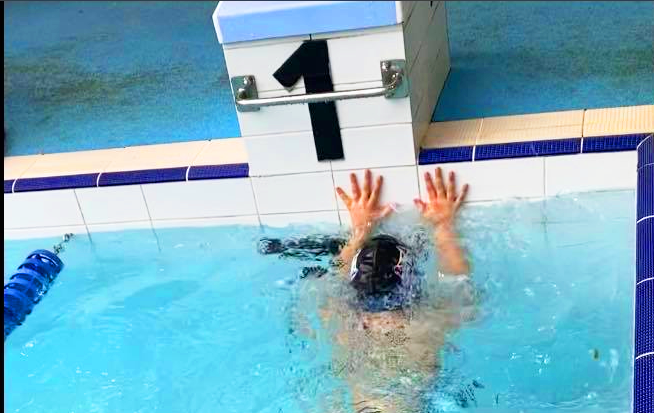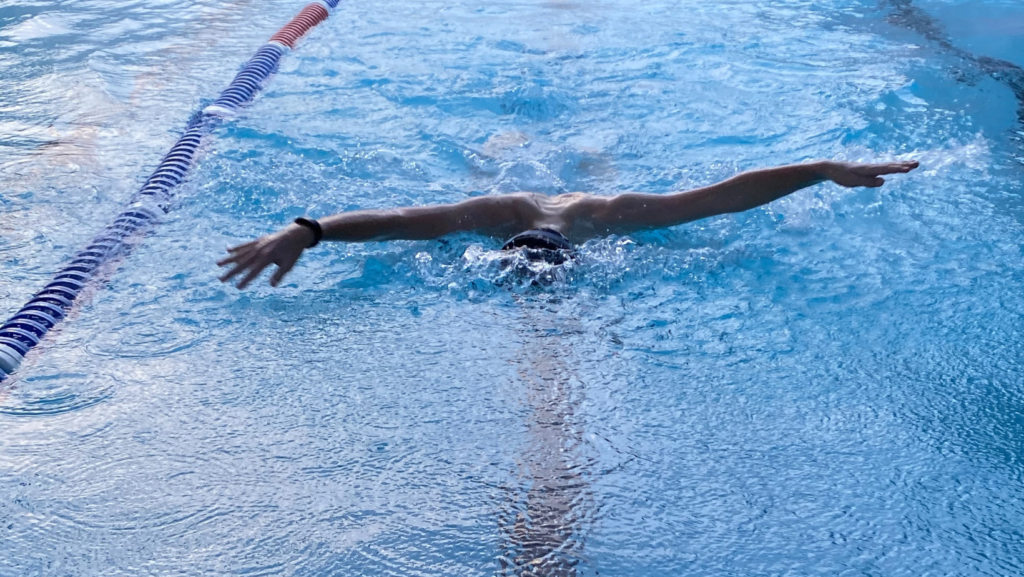Which turn to use for which swim stroke?
For our symmetrical strokes, butterfly and breaststroke, we use ‘touch turns’, which requires a two–handed touch and quick tuck-and-turn to continue with speed. Whilst this may seem the simple technical turn, it still requires concentration and timing to ensure a full stroke before the glide phase.
The fastest way to change direction at the wall when swimming freestyle or backstroke is using a tumble turn, also known as flip turns. Tumble Turns are a technique used to transition from one lap to the next without stopping. This is where we start our somersault with our head tucked down.
Touch-turns in Breaststroke and Butterfly.
Performing a touch turn in breaststroke and butterfly involves smoothly transitioning from swimming towards the pool wall to pushing off and continuing the swim. Here’s a step-by-step guide for executing a touch turn in breaststroke and in butterfly.

How to perform a touch turn in Breaststroke:
- Approach the Wall – Swim towards the pool wall using the breaststroke technique.
- Timing – Start the turn when you are about one arm’s length away from the wall.
- Final Stroke – Take your final breaststroke arm pull, bringing your hands towards your chest.
- Glide and Extend – Glide for a moment with your arms extended forward.
- Rock and roll – after making contact with two hands at the wall, rock backwards to plant both feet at the wall, rotate your body quickly and bring your feet over, positioning them to hit the wall.
- Push Off – Push off the wall with your legs. You can execute a breaststroke kick or a dolphin kick to gain momentum.
- Underwater Phase – Glide underwater with streamlined arms and either a breaststroke kick or dolphin kick, maintaining a streamlined position.
- Start your breaststroke pull and kick after the underwater phase and continue swimming.
How to perform a touch turn in Butterfly:
- Approach the wall – swim towards the pool wall using the butterfly stroke technique.
- Timing – start the turn when you are about one arm’s length away from the wall.

- Final stroke – take your final butterfly arm pull, bringing your hands towards your hips.
- Glider and extend – glide for a moment with your arms extended forward.
- Touch the wall – extend your arms forward and use your hands to reach out and touch the wall simultaneously.
- Leg position – rotate your body quickly and bring your feet over, positioning them to hit the wall.
- Push off – push off the wall with your legs. You can execute a dolphin kick to gain momentum.
- Underwater phase – glide underwater with streamlined arms and perform a dolphin kick, maintaining a streamlined position.
- Breakout – start your butterfly arm pull and dolphin kick after the underwater phase and continue swimming.
Tips for an Efficient Breaststroke and Butterfly Touch Turn:
Practice Timing: Work on the timing of your turn to ensure you initiate the somersault at the right distance from the wall.
Streamline Position: Maintain a streamlined position both during the touch and the push-off to reduce resistance in the water.
Powerful Push-Off: Use a strong push-off from the wall to gain momentum for the next lap.
Underwater Glide: Make the most of the underwater phase by gliding efficiently before starting your next breaststroke pull and kick.
Consistency: Practice touch turns regularly to build muscle memory and improve the fluidity of your breaststroke turns.
Remember to adapt these steps to your comfort and swimming style. Consistent practice and refinement will contribute to more efficient and effective touch turns in breaststroke.
Tumble-turns in Freestyle and Backstroke.
The fastest way to change direction at the wall when swimming freestyle or backstroke is using a tumble turn, also known as flip turns. Tumble Turns are a technique used to transition from one lap to the next without stopping. This is where we start our somersault with our head tucked down.
Here’s how you can perform tumble turns for Freestyle:
- Approach the Wall – Swim towards the pool wall using a strong freestyle stroke.
- Timing – Start the turn when you are about two arm’s length away from the wall.
- Final Stroke – Take your final freestyle stroke with your arm extended.
- Tuck and Rotate – Tuck your chin towards your chest and perform a somersault in the water. Rotate your body quickly to bring your feet over your head.
- Leg Position – As your feet come over, position them to hit the wall with your feet together.
- Push Off – Use your feet to push off the wall with power. Streamline your body with arms extended forward.
- Underwater Phase- Glide underwater in a streamlined position, dolphin kicking if needed.
- Breakout – Start your freestyle stroke again after the breakout and continue swimming.
Backstroke: Turns for backstroke is like freestyle, with our swim starting on our back. Counting the strokes from the flags is essential for a correct and safe turn at the wall. In a 50m race rolling onto the front for the turn is permitted if the legs do not kick, and only one arm assists with the flip. We perform the turn just like in freestyle, but we stay on our back after pushing off the wall, in our streamline position of course! In the backstroke leg of an IM there are no tumble turns, and then we must finish on the back. This turn heavily relies of the glide. We can transition from backstroke to breaststroke with one of three (3) turns. We can practice this in class!
Here’s how you can perform tumble turns for Backstroke:
- Approach the Wall – Swim on your back towards the pool wall using the backstroke technique.
- Timing – Count your strokes and begin the turn when you are about two arm’s length away from the wall.
- Final Stroke – Take your final backstroke arm pull.
- Tuck and Rotate – Tuck your chin towards your chest and initiate a somersault.
- Leg Position – Rotate your body quickly and bring your feet over, positioning them to hit the wall with your feet together.
- Push Off – Use your feet to push off the wall. Streamline your body with arms extended backward in a streamlined position.
- Underwater Phase – Glide underwater, maintaining a streamlined position. Dolphin kicking can be used to gain momentum.
- Breakout – After the underwater phase, initiate the backstroke arm stroke again and continue swimming on your back.
